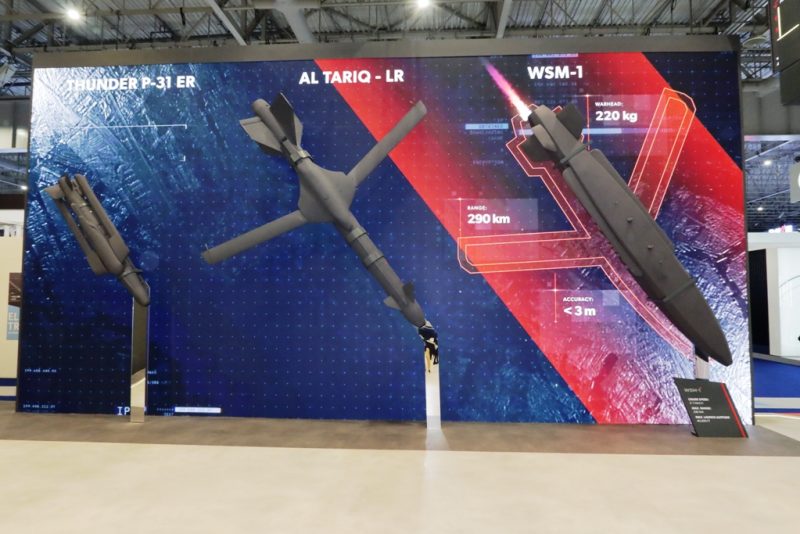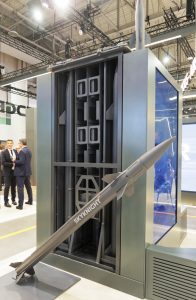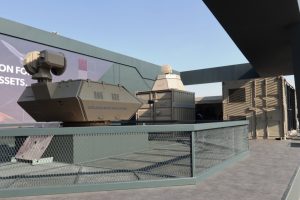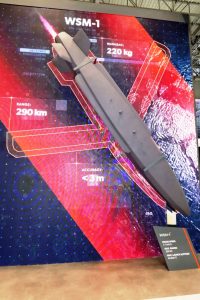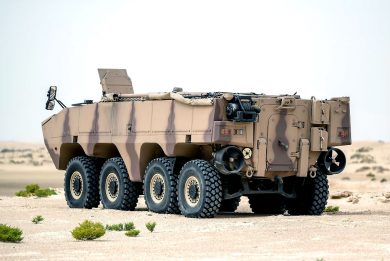Dubai Airshow 2025 – EDGE Halcon adds new air-to-ground effectors to its portfolio and advances in the ground-based air defence field
At the Dubai Airshow Halcon, part of the EDGE Missiles and Weapons cluster, presented several novelties, some of them remaining however quite secretive as not many details were unveiled. New effectors were all in the air-to-ground area, while the company ground-based air defence missile system is closing the end of development
One of the major new products unveiled at the Dubai exhibition was the Thunder ER. This leverages on the success of the two Thunders, the P31 and P32, the are cost-effective, short-range, guidance kits that can be fitted to the MK-82 (P-32) and the MK-81 (P-31) general purpose aerial munitions. They feature GNSS guidance, and are available also in the semi-active laser guidance configuration which considerably improves accuracy, also allowing to deal with moving targets.
“Both the P-31 and P-32 have been in production for several years, and they are in operation with the local user,” Saeed Al Shamsi, Halcon acting CEO told EDR On-Line. Adding that with the Thunder ER his company aimed at adding range to the system. “According to our simulations and analyses, adding an aerodynamic mechanical wing kit to the Thunder family, we can increase the range from 20 kilometres, which is the current standard one, up to possibly 80 kilometres, and this without any type of propulsion, adding considerable value to the weapon itself.” These ranges are obtained when the Thunders are released by a fighter flying at high altitude and high speed, EDR On-Line understood. “The Thunder ER maintains the same seeker, the same guidance module, the same tail kit of existing Thunders, so it is a modular upgrade. The new version is currently under development, and we plan starting flight tests next year,” the company acting CEO announced. The very short development time is allowed by the fact that the weapon is available and adding a wing is a relatively simple operation, also considering that Halcon leverages the 10 years plus experience acquired with the Al-Tariq kits.
Another reason is that all EDGE companies can reuse building block available across the Group, which allows saving cost and reduce development timelines, a key factor as in recent times emerging needs must be answered as quickly as possible. “We are investing heavily in our production capabilities,” Saeed Al Shamsi said, adding that “one way of doing it is adopting smart technologies, adopting automated lines, adopting robotics. And this is not unique to Halcon, it is across all the EDGE community.”
With first launch tests scheduled for 2026, the Thunder ER should become available on the market one year later, EDR On-Line understood. As for mass production, Halcon maintains in house the full weapon assembly, however the manufacturing of many components is outsources, both to national and international subcontractors.
A product which approaches the end of the development cycle is the SkyKnight surface-air-air missile, which is a key element within the Skynex layered air defence system developed together with Rheinmetall.
“Air defence is a major issue on which we have been investing and developing for several years now.” At IDEX a video showing first tests were shown, but since several launches were made, Halcon moving steadily along the development path. “All are part of the programme flight test campaign, the acting CEO told us, adding that 2025 was a key year for the SkyKnight, in terms of achieving several milestones of the missile itself. “The missile subsystems are maturing day by day, and every time we accomplish a flight test, we tick one box,” he said, adding that when dealing with complex air defence systems there is a point at which industry must necessarily interface with the customer to do final qualifications. “We expect to come to the full system qualification in late 2027, which will include missiles, guns, radar, and command and control.” Radar and guns are coming from Rheinmetall Italia, and are proven in-service components, the same being true for the command and control component.
“Today our focus is getting the missile to work seamlessly with the radar and the C2, and Rheinmetall has the experience for combining guns with missiles. This SkyKnight/Skynex solution is really a joint development with Rheinmetall.” Looking at the future of Halcon, Saeed Al Shamsi explains that the company will remain engaged on both air-to-ground and air defence. “In the air defence field the Skynex will enable us to set the scene. From there onwards, we will tackle the next layers one by one, and we will adopt similar methodologies where we reuse building blocks and subsystems wherever possible, and we will develop new ones wherever needed. And the same goes for air-to-ground. If you came to EDGE four years ago, you would not see cruise missiles, but today you are seeing multiple cruise missiles and all this because we are using building blocks and tackling one obstacle after the other.” The acting CEO explained.
As for systems dimensions, Halcon is considering both smaller and bigger options, much depending on customers’ requirements.
During the exhibition the veil was lifted on many details regarding the WSM-1, which the company defines a next-generation low-cost cruise missile that bridges the gap between long range glide precision guided munitions, and conventional air-launched cruise missiles. A turbojet powered cruise missile, the WSM-1 is capable to fly at a speed up to Mach 0.7, and reach targets at 290 km carrying a 220 kg warhead, which can be a high-explosive pre-formed fragmented or a penetrator. The WSM-1 can fly at altitudes up to 40,000 ft and dive on the target, hitting it with a 3 metres accuracy thanks to its navigation and targeting sensors. In the final attack phase guidance is provided by a next-generation imaging infrared seeker, while a resilient anti-jamming global navigation satellite system (GNSS) aided with an inertial navigation system (INS) ensure the WSM-1 reaches the target area, where the IIR sensor takes over. Other advanced features include artificial intelligence-assisted terminal retargeting, 3D waypoint navigation, and dynamic flight and attack profiles. No information was released on the programme status.
Photos by P. Valpolini

